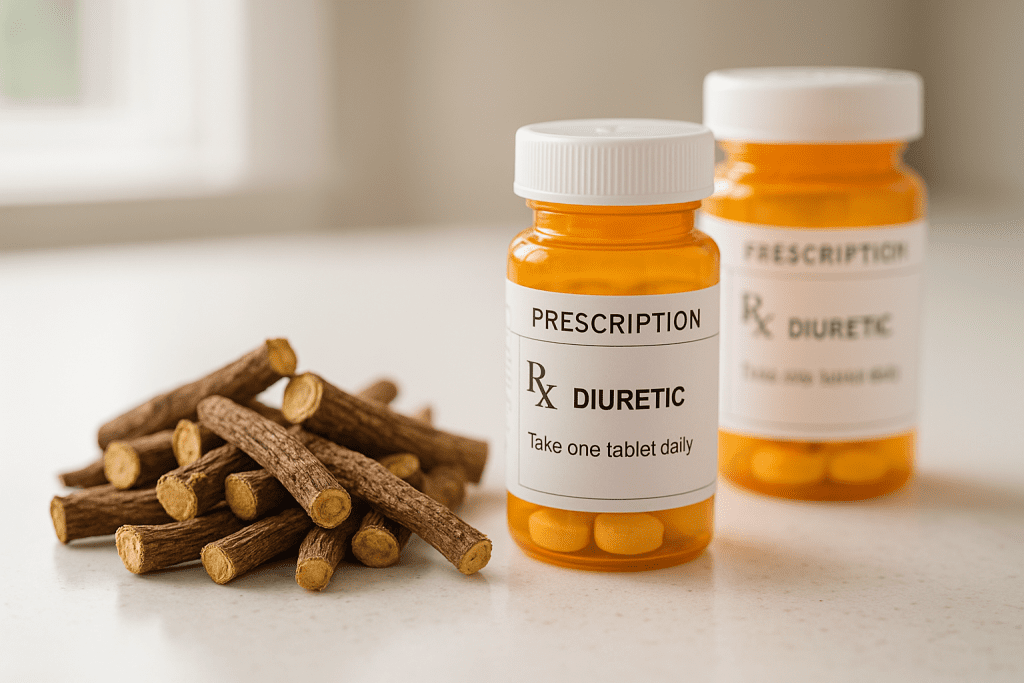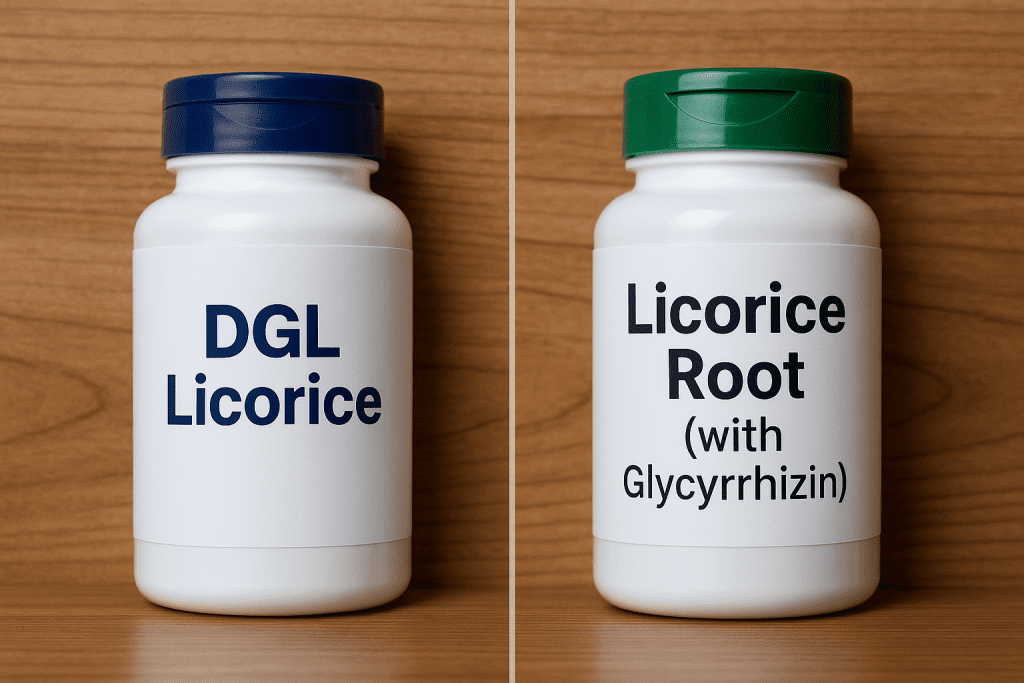
Licorice Root and Diuretics: What You Need to Know
Licorice root supplements may seem harmless, but combining them with diuretics can trigger dangerous drops in potassium—known as hypokalemia—and other life-threatening imbalances. This guide explains the mechanisms behind this risk, how to recognize early warning signs, and best practices for using licorice safely, especially if you’re on medications that affect your electrolyte levels.
Quick Answer: Should You Mix Licorice Root with Diuretics?
| Concern | Impact |
|---|---|
| Primary Risk | Severe potassium depletion (hypokalemia) |
| Why It Happens | Licorice increases cortisol effect, boosting sodium retention + potassium loss |
| High-Risk Meds | Loop and thiazide diuretics |
| Warning Signs | Muscle weakness, irregular heartbeat, fatigue |
| Safe Use Tips | Avoid glycyrrhizin forms, monitor electrolytes, consult your doctor |
Bottom line: The licorice root diuretic interaction poses a serious hypokalemia risk and can worsen licorice supplement side effects. Caution and medical supervision are essential.
How Licorice Root Affects Cortisol, Potassium, and Blood Pressure
Licorice root contains glycyrrhizin, a compound that alters how your body handles cortisol—a hormone with powerful effects on fluid balance. Glycyrrhizin inhibits the enzyme 11β-hydroxysteroid dehydrogenase, which normally protects mineralocorticoid receptors from excess cortisol. When this enzyme is blocked, cortisol behaves like aldosterone, prompting your kidneys to retain sodium and eliminate potassium.
This process creates a condition called pseudo-hyperaldosteronism, marked by fluid retention, hypertension, and hypokalemia. If you’re also taking diuretics—which themselves deplete potassium—the combination can cause potassium levels to plummet quickly.
A case report in Medicine (Baltimore) documented an 84-year-old woman who developed partial paralysis and high blood pressure after drinking licorice tea while on thiazide diuretics. Her recovery only began after potassium supplementation and switching to a potassium-sparing medication.
Licorice and Diuretics: The Clinical Evidence
Multiple studies and case reports confirm that chronic licorice intake, especially alongside diuretics, amplifies the risk of dangerous hypokalemia. According to the Journal of Clinical Medicine, potassium levels can fall below 2.0 mmol/L—far below the safe threshold—leading to serious outcomes like cardiac arrhythmias.
A case reviewed in PubMed Central showed cardiac arrest linked to licorice-induced hypokalemia, with potassium measured at a life-threatening 1.6 mmol/L. These outcomes underscore why licorice root supplements and diuretic depletion require close monitoring.
See also: Potassium supplements and ACE inhibitor dangers
How to Spot Early Signs of Hypokalemia

Electrolyte imbalances often start subtly. If you’re using licorice and taking diuretics, watch for these red flags:
1. Muscle and Neuromuscular Symptoms
- Persistent fatigue and leg weakness
- Cramps, twitching, or spasms
- Tingling or numbness
- Severe cases may involve limb paresis (partial paralysis)
These occur because potassium is essential for muscle and nerve signaling.
2. Heart and Blood Pressure Changes
- Palpitations or irregular heartbeats
- High blood pressure
- ECG abnormalities (e.g., U waves, QT prolongation)
- Risk of arrhythmias like torsades de pointes
3. Other Red Flags
- Swelling in legs or ankles (peripheral edema)
- Excessive thirst or frequent urination
- Headaches or mental confusion
- Constipation or nausea
These signs indicate that your sodium-potassium balance is off—a known consequence of mixing licorice with potassium-depleting diuretics.
See also: Muscle cramps from diuretics and potassium supplements
Licorice Supplement Side Effects: Doses, Duration, and Safer Alternatives

Recommended Dosage and Limits
Most health organizations recommend an acceptable daily intake (ADI) of glycyrrhizin at 0.2 mg/kg/day. However, the actual content in licorice products varies dramatically depending on species and preparation method.
- Dried root powder: 1–5 grams up to three times daily
- Tincture (1:5 strength): 2–5 mL up to three times daily
If you’re on diuretics, even these common doses may be too high. The safest path? Avoid glycyrrhizin altogether or use only under medical guidance.
Duration: Why You Should Take Breaks
Long-term use of licorice, especially over 4–6 weeks, increases your risk of cumulative mineralocorticoid-like effects. To reduce risk:
- Limit licorice to short-term use
- Take breaks (“licorice holidays”) between courses
- Avoid multiple licorice-containing products at once
Best Practice: Switch to DGL Licorice
Deglycyrrhizinated licorice (DGL) has glycyrrhizin removed and does not affect potassium levels, making it a safer alternative if you’re using licorice for digestive issues. According to Healthline, DGL offers anti-inflammatory benefits for ulcers and GERD without impacting fluid and electrolyte balance.
Safe Use Guidelines for People on Diuretics
If you’re using diuretics for blood pressure, heart conditions, or edema, these guidelines can help you stay safe:
- Avoid full-spectrum licorice with glycyrrhizin
- Use DGL instead for stomach support
- Get regular lab tests to monitor potassium and sodium
- Talk to your doctor before starting any licorice-containing product
- Be cautious with loop and thiazide diuretics, which dramatically increase potassium loss
- Patients with kidney disease, hypertension, or heart failure should avoid licorice altogether
Medical oversight is especially important for anyone managing electrolyte-sensitive conditions. Always report any new supplements or symptoms to your provider.
Conclusion: Don’t Underestimate the Licorice-Diuretic Combo
Licorice root might be natural, but its interaction with diuretics is far from benign. From altering cortisol activity to dangerously lowering potassium, this combo can create a metabolic storm. Whether you’re sipping licorice tea or taking capsules, it’s essential to understand how even small amounts can add up—especially when medications already influence your body’s fluid balance.
To stay safe:
- Avoid glycyrrhizin-containing products if you’re on diuretics
- Consider switching to DGL licorice for digestive health
- Watch for early signs like cramps or palpitations
- Monitor your labs and stay in communication with your healthcare team
For more on related risks, check out our post on Potassium supplements and ACE inhibitor dangers.

